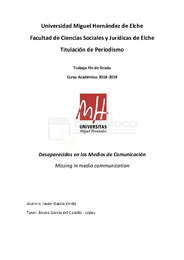Please use this identifier to cite or link to this item:
https://hdl.handle.net/11000/7912Full metadata record
| DC Field | Value | Language |
|---|---|---|
| dc.contributor.advisor | García del Castillo López, Álvaro | - |
| dc.contributor.author | García Verdú, Javier | - |
| dc.contributor.other | Departamentos de la UMH::Ciencias Sociales y Humanas | es |
| dc.date.accessioned | 2021-06-03T12:51:59Z | - |
| dc.date.available | 2021-06-03T12:51:59Z | - |
| dc.date.created | 2019-09 | - |
| dc.date.issued | 2021-06-03 | - |
| dc.identifier.uri | http://hdl.handle.net/11000/7912 | - |
| dc.description.abstract | Gabriel Cruz, Julen Jiménez, Diana Quer, Marta del Castillo, Yéremy Vargas o las niñas de Alcàsser son algunas de las víctimas de los casos de desapariciones más conocidos y mediáticos de los últimos años en nuestro país. Sin embargo, ¿Qué los hace especiales? Según el Ministerio del Interior, cada año en España desaparecen en torno a 14.000 personas. Es evidente que los medios juegan un papel fundamental en la difusión de estos sucesos. La pregunta es: ¿Lo hacen de forma correcta? Desde hace ya muchos años, la prensa es sensacionalista, busca el morbo para conseguir audiencia y vulnera los derechos de las víctimas con total impunidad. Por ello, el principal objetivo de este trabajo es: Analizar, a través de la visión de diversos expertos, las noticias morbosas vertidas por algunos periodistas; explicar por qué unos sucesos se vuelven más mediáticos que otros; remarcar cuáles son las leyes que protegen a las víctimas de la violación de sus derechos; comprobar si la prensa entorpece las investigaciones policiales; determinar cuál debe ser la actitud de los periodistas cuando poseen información sensible; y descubrir si la población se vuelve cada vez más sensacionalista al consumir contenidos de este tipo. | es |
| dc.description.abstract | Gabriel Cruz, Julen Jiménez, Diana Quer, Marta del Castillo, Yéremy Vargas or the Alcàsser girls are some of the victims of the best known and media cases of disappearances of recent years in our country. However, what makes them special? According to the Ministry of Interior, around 14,000 people disappear every year in Spain. It is evident that the media play a fundamental role in the dissemination of these events. The question is: Do they do it correctly? For many years now, the press has been sensational, seeks morbidity to get an audience and violates the rights of victims with impunity. Therefore, the main objective of this work is: To analyze, through the vision of various experts, the morbid news published by some journalists; explain why some events become more media than others; highlight what are the laws that protect victims from the violation of their rights; check if the press hinders police investigations; determine what the attitude of journalists should be when they have sensitive information; and discover if the population becomes increasingly sensational when consuming content of this type. | es |
| dc.format | application/pdf | es |
| dc.format.extent | 28 | es |
| dc.language.iso | spa | es |
| dc.rights | info:eu-repo/semantics/openAccess | es |
| dc.subject | sensacionalismo | es |
| dc.subject | sensationalism | es |
| dc.subject | personas desaparecidas | es |
| dc.subject | coberturas informativas | es |
| dc.subject | bulos | es |
| dc.subject | redes sociales | es |
| dc.subject | missing people | es |
| dc.subject | information coverages | es |
| dc.subject | canard | es |
| dc.subject | social network | es |
| dc.subject.other | CDU::0 - Generalidades.::070 - Periódicos. Prensa. Periodismo. Ciencias de la información | es |
| dc.title | Desaparecidos en los Medios de Comunicación | es |
| dc.title.alternative | Missing in media communication | es |
| dc.type | info:eu-repo/semantics/bachelorThesis | es |

View/Open:
GARCÍA VERDÚ JAVIER.pdf
7,38 MB
Adobe PDF
Share:
.png)
